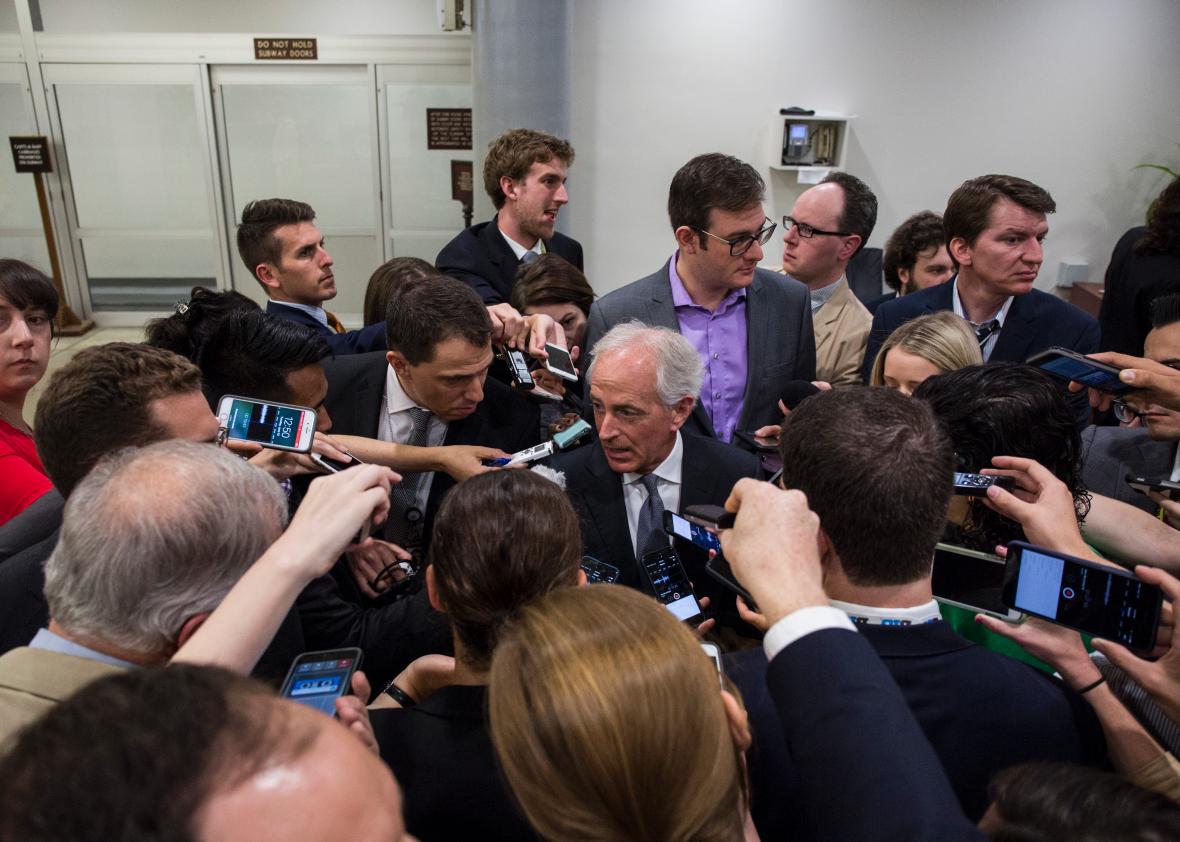On Monday I was speaking to a veteran Senate reporter about the increasing number of journalists flooding the halls of the Capitol. This reporter felt that the crowd size would “inevitably” lead to the end of the open press access the media has long enjoyed. This reporter was not the first that I’d heard that from. It was not the first time that I’d thought about it, either. There’s a vague sense among many members of the Capitol Hill press corps that some sort of crackdown is coming and that the incredible access to national lawmakers that reporters enjoy could be curtailed.
This is partly why so many journalists lost their minds Tuesday when television reporters were told that they could no longer conduct on-camera interviews with lawmakers absent permission from the Senate Rules Committee—a bureaucratic nightmare that, for television reporters, would render Capitol Hill coverage moot. After a brief outcry, Senate Rules Committee Chairman Richard Shelby issued a statement saying that the committee “has made no changes to the existing rules governing press coverage on the Senate side of the Capitol complex.” He did note, however, that the committee had been working with press galleries to “ensure compliance with existing rules” to guarantee a “safe environment” for everyone.
The “safety” justification is not a total fabrication. The place is mobbed these days. Another veteran reporter I spoke to estimated that under the Trump administration there are about double the number of reporters on the Hill as there used to be, on average legislative days. On the Senate side, reporters huddle in the basement where the Senate subway cars arrive from the Russell, Hart, and Dirksen office buildings. It’s not that large of a platform. As soon as key senators emerge from the cars, they are met with 20 or 30 microphones jammed into their faces. The moving press horde ascends a flight of stairs and proceeds another 50 feet or so until the senators can escape into the members-only elevator. Once the senators reach the second floor, where the Senate chamber is, they will meet the same scene from reporters stationed there, before escaping into the chamber or a private room.
Senators tend to be very old. Orrin Hatch, for example, is 83. Anytime Hatch is in the Capitol, 3 to 4 million reporters surround him, since he runs the committee with health care and tax reform jurisdiction. (And because he’s a legend.) Someone could trip, fall into Hatch, and down Hatch would go. That would not be good.
The reason there are so many reporters on the Hill, though, is because there’s a lot of news on the Hill. The government is unified under control of one party for the first time in several Congresses, and it is working to achieve long-standing ideological goals. The head of that unified government is a strange game-show host with many opinions and a questionable grasp of the facts. The FBI and two select congressional committees are conducting investigations into Russian interference in the election. The simple reason for why there’s twice the number of reporters on the Hill now is because there’s twice the amount of news coming from the Hill. At least.
Very rarely are the majority of these reporters asking Republican lawmakers questions that they’re thrilled to answer. Queries are more like: Sen. Bob Corker, chairman of the Foreign Relations Committee, what do you think of Trump bashing a U.S. ally in a series of tweets this morning? Or: Sen. Jeff Flake, you’re in danger of losing next year. Will you support a bill that ends the Medicaid expansion in your state? And: Do you think that it was appropriate for the president to issue a veiled threat to the FBI director and then fire him? Do you believe that the president is capable of handling classified information? When will you show your health care bill to the public? Might safety concerns suddenly seem like more of an urgent matter to you, if you were regularly subjected to these sorts of questions? That’s where the angst, at least for me, comes from: There are too many of us, asking too many questions that they don’t want to answer, all the time, for this to last.
White House and campaign reporters do not have anything close to the access to principals that my colleagues and I get on Capitol Hill. At the White House, you go through Sean Spicer’s shop. On the trail, you’re typically relegated to a press area. On the Hill, you can just be walking down the hall and see, say, Sen. John McCain, all by himself, and ask him whatever questions you please. There is no requirement that a senator or a member of the House respond, but silence itself can be an answer. If open press access on the Hill was restricted, one more branch of public communication would be conducted exclusively through flacks, and one more check on power would be impeded.
If senators truly are concerned about the size of reporter mobs and their safety, they could be more forthcoming with information about, say, their health care bill, perhaps with regular press conferences. Reporters wouldn’t have to be quite so creative in their methods, then.
Until that day, which will never come, let’s be careful not to trip Orrin Hatch.
